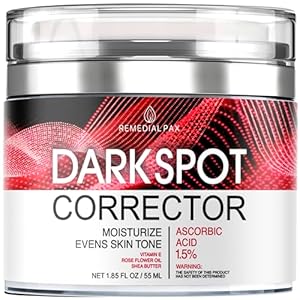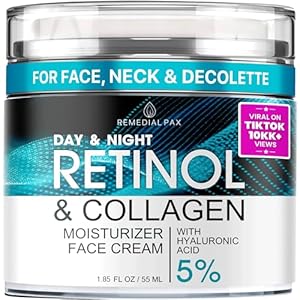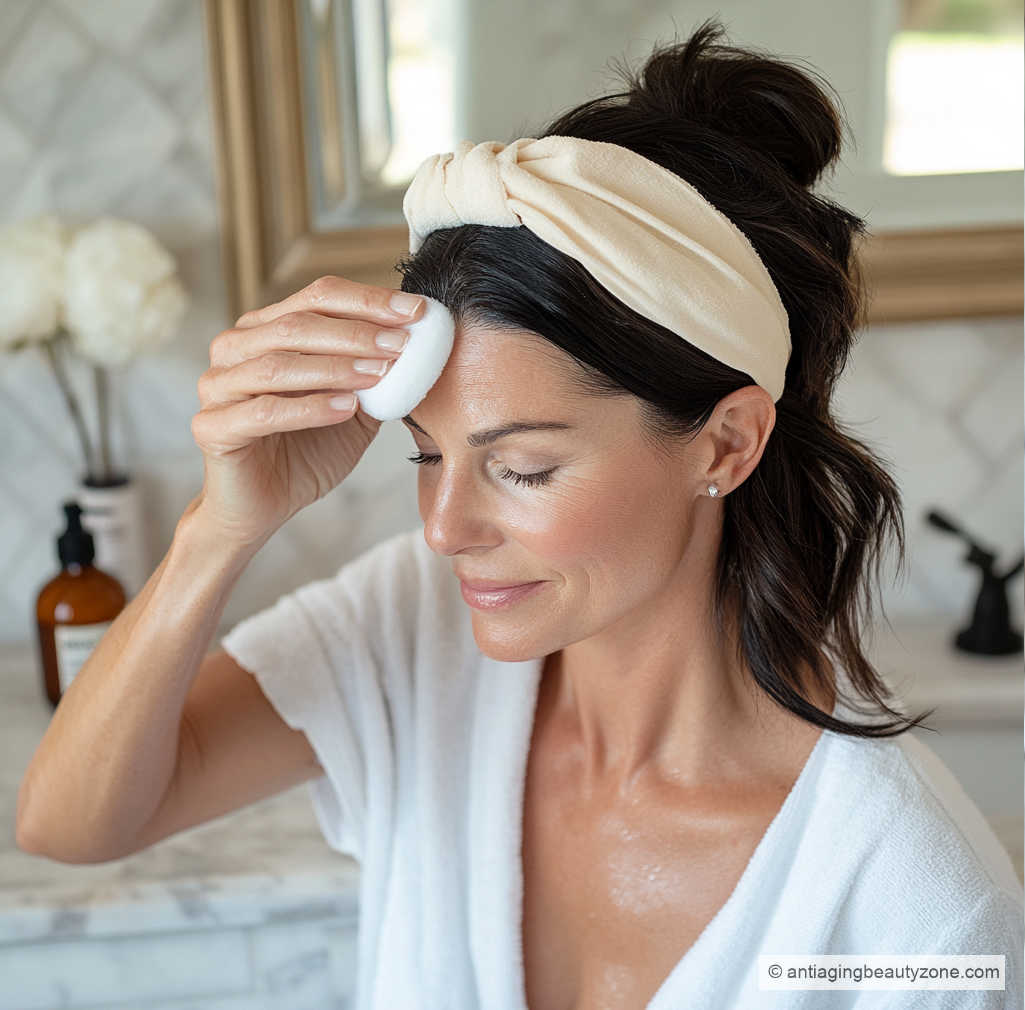
by: Linda Robison
I’ve always been a fan of acids, especially for aging skin. Using glycolic and lactic acid together is one of my favorite strategies because they help exfoliate, smooth, and brighten the skin.

Each acid has its strengths, and when combined in a routine—if done right—they can give you that extra boost for a radiant complexion. Best of all, they’re inexpensive!
Understanding: Basics of glycolic and lactic acids
Both acids work wonders for resurfacing the skin, but they each bring something different to the table.
Glycolic Acid:
- Derived from sugar cane, it has the smallest molecules among AHAs (alpha hydroxy acids), enabling deep penetration and exfoliation. It improves skin tone, texture, and overall appearance by reducing fine lines, wrinkles, hyperpigmentation, and acne scars. Its efficacy depends on concentration and pH level, with higher concentrations and lower pH offering stronger exfoliation but potentially irritating sensitive skin.
Lactic Acid:
- A milder AHA with larger molecules, provides gentler exfoliation and better hydration than glycolic acid, making it suitable for sensitive or dry skin. Its effectiveness, however, still hinges on concentration and pH. Higher concentrations and lower pH levels can enhance exfoliation but may heighten irritation risk. Used correctly, lactic acid effectively improves skin texture and tone while minimizing irritation.
Is it safe to use both? Yes—but not together unless they’re in a single formula. To avoid irritation, alternate their use. Both acids can work beautifully in your routine, but it’s all about balance.
Choosing Products: Serums, Toners, and Peels
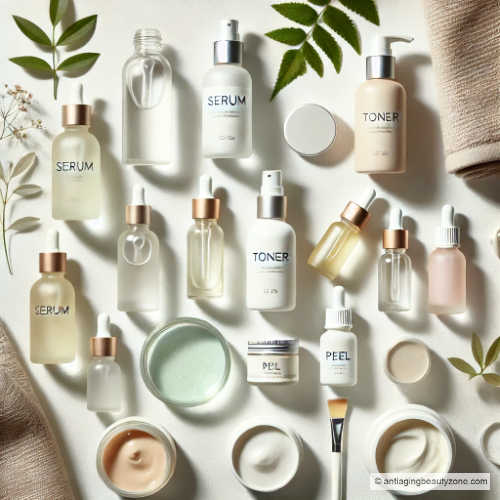
When it comes to using AHA’s, the right product choice makes all the difference. Here’s a quick rundown of the types of products you can use:
1. Serums
Serums are concentrated formulas that deliver potent ingredients directly into your skin. Look for glycolic or lactic acid serums with a balanced pH to maximize benefits. They’re great for targeted treatment.
2. Toners
Toners help prep your skin for the next steps. Opt for an exfoliating toner that contains one of these acids. Use it after cleansing to help remove leftover impurities and refine pores.
3. Peels
Peels offer a more intense experience, providing deeper exfoliation. You can find both glycolic and lactic acid peels in various strengths. Use them as directed, typically once a week, for a noticeable glow.
Mixing and Matching
You don’t need to stick to just one type. Feel free to mix and match! For example, use a glycolic acid serum on alternate nights and a lactic acid toner in the morning. This keeps your routine effective without overwhelming your skin.
Important Reminder
Always read product instructions. Since both acids can be strong, pay attention to your skin’s response and adjust frequency if needed. If irritation occurs, dial back and give your skin a break.
How to safely combine glycolic and lactic acids
When using both acids, it’s all about balance. While they each offer their own perks, using them together—without care—can lead to irritation. The key? Alternate them. Also, always check out the specific instructions on the product label. This is most important!!
Avoid Over-Exfoliating
Never layer them on the same day unless they’re in a single, specially formulated product. Instead, use one on a specific day, then swap it out for the other on a different night. This approach prevents over-exfoliation while letting each product do its job.
Start Slow
If you’re new to acids, go easy at first. Try using each once or twice a week on different days (with a few days rest in-between) to see how your skin reacts. If everything feels fine, you can gradually increase the frequency. Always listen to your skin—tightness or redness means you might need to dial it back.
Product Strength Matters
Stronger formulas (like peels) should be used less frequently than milder options like toners or serums. If your skin feels sensitive, stick with lower concentrations. Best bet is to check the recommendations on the label.
Guidelines for general usage based on percentage:
Lactic acid and glycolic acid share similar general guidelines for usage based on their concentrations, though glycolic acid tends to be stronger due to its smaller molecular size, allowing it to penetrate the skin more deeply.
Here’s a breakdown for both acids. But always remember to follow product recommendations.
Lactic Acid
- Low concentrations (5%-10%): Safe for frequent use, even daily or every other day if your skin tolerates it. Common in toners, serums, and mild peels for gentle exfoliation and hydration.
- Moderate concentrations (10%-20%): Best used 2-3 times a week, offering deeper exfoliation without overwhelming the skin.
- High concentrations (20%-30%): Found in more intense at-home peels. Use no more than once a week, depending on your skin’s sensitivity.
- Professional-grade (35% and above): Reserved for professional treatments. Strong enough to require application by a trained professional to avoid burns or irritation.
Glycolic Acid
- Low concentrations (up to 10%): Similar to lactic acid, safe for frequent use every other day or even daily, depending on tolerance. Often found in over-the-counter products.
- Moderate concentrations (10%-20%): Recommended for use 2-3 times a week, providing deeper exfoliation to tackle concerns like uneven texture or hyperpigmentation.
- High concentrations (20%-30%): Typically used for stronger at-home peels, with caution. Limit to once a week.
- Professional-grade (35% and above): Applied by professionals only. These peels are stronger, requiring careful monitoring to avoid skin damage.
Both acids can enhance your skincare routine, but glycolic acid tends to be more intense. For those using both, spacing out applications—such as using lactic acid one day and glycolic on another—helps prevent irritation.
How often should you use them?
Easy Into It
If you’re just getting started with these exfoliating acids, take it easy. Begin by using each one just once or twice a week, allowing a few days rest between applications. This lets your skin adjust, helps avoid irritation, and gives you an idea of how well your complexion can tolerate them.
Introducing Them to Your Routine
For those with sensitive skin, start with mild lactic acid. It’s gentler and will help your skin build up tolerance. After a few weeks, you can alternate and add glycolic acid on different nights. If your skin is less sensitive, you can kick things off with glycolic acid first.
Which One Goes First?
If you don’t have very sensitive skin, start with glycolic acid. Its smaller molecules allow for deeper exfoliation. Use lactic acid on separate days for hydration and gentle renewal. Never use both at once unless they’re in the same product.
Step-by-Step Guide: Layering the acids
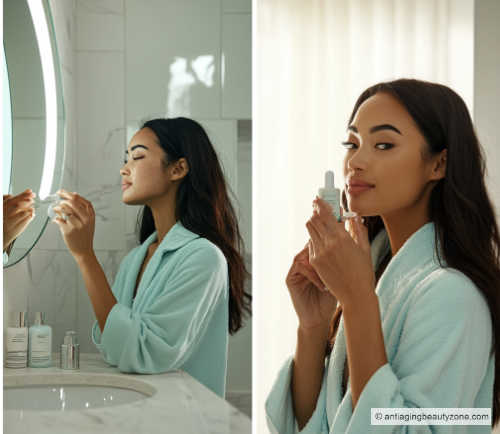
Here’s an easy “sample” routine to help you incorporate both acids without overwhelming your skin. The key is to use them on different days or at different times and find a schedule that works for you.
Morning Routine
- Lactic acid is mild enough for daytime use. After cleansing, apply a toner or serum containing lactic acid. Follow up with a hydrating moisturizer and, most importantly, sunscreen. Exfoliating makes your skin more sensitive to UV rays, so protection is a must.
Night Routine
- On non-lactic acids days, apply glycolic acid at night, as it’s stronger and penetrates deeper. After cleansing, apply a glycolic-based toner, serum, or peel. Follow with a soothing moisturizer to lock in hydration and prevent any dryness or irritation.
Can You Use One in the Morning and One at Night?
No, it’s best to avoid using both acids on the same day. Remember, since both acids exfoliate, don’t use them on the same day unless they’re in a combined formula.
What If You Use Retinol?
Many women use retinol, especially in anti-aging routines. If you do, avoid using it on the same night as glycolic acid to prevent irritation. You can alternate between retinol and glycolic acid, while still using lactic acid in the morning. And always pay attention to your complexion! Redness or irritation is a sign it’s too much for your skin type!
Don’t forget to moisturize!
Importance of Hydration
After using acids, it’s crucial to moisturize. These products can dry out your skin, so keep it hydrated with a moisturizer that has ingredients like hyaluronic acid or ceramides to strengthen the skin barrier.
Recommended Products
Choose lightweight, non-comedogenic moisturizers that won’t clog pores. Gel-based formulas work well if you have oily skin, while richer creams are great for drier skin types.
Sunscreen is a must!
Since acids make your skin more sensitive to the sun, daily sunscreen is essential to protect against sun damage. Choose SPF 30 or higher to keep your skin safe and prevent signs of aging.
Signs of over-exfoliation and how to fix it
Irritation, redness, or flakiness are signs of over-exfoliation. This indicates inflammation, which can actually age your skin over time. If this happens, stop using acids and focus on calming, hydrating products.
How to Soothe Irritated Skin
Use calming creams with panthenol or niacinamide. Skip ALL exfoliation until your skin feels balanced again.
Answer: While glycolic acid helps remove dead skin cells, and retinol boosts skin cell turnover, dermatologists recommend alternating their use due to the potential for irritation when used simultaneously. If you have sensitive skin, it’s best to consult your dermatologist before combining these ingredients.
Answer: Only in specially formulated products; otherwise, alternate.
Answer: Avoid using retinol and glycolic acid on the same night. Alternate them.
Answer: Yes but use vitamin C at different times. This shouldn’t be a problem since you would use vitamin C everyday and the acids only on certain days of the week/month. On the days you use the acids, skip the vitamin C.
Takeaway:
Layering these exfoliating acids can help brighten and smooth your skin when used correctly. Analyze your skin to determine if you need a deeper exfoliation treatment; if it looks really dull or flaky, reach for glycolic acid. If it’s just a little dull, a lactic acid refresh might be all it needs.
Just remember to alternate their use, keep your skin moisturized, and wear sunscreen every day. With these simple steps, you can enjoy a fresh, youthful look at any age without breaking the bank. It’s an easy and affordable way to enhance your skincare routine!
Before you go…
If you enjoyed this content, show some love by tapping the 💙 in the bottom right corner (you’ll find it on almost every page). It lets me know you found it helpful and fun. Thanks a bunch!
Trending Products

